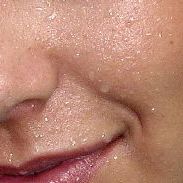ချွေးထွက်ခြင်း
ချွေး (သို့) ချွေးထွက်ခြင်း (အင်္ဂလိပ်: perspiration or sweating) သည် နို့တိုက်သတ္တဝါများ၏ အရေပြားရှိ ချွေးဂလန်းများက ထွက်ရှိသော အရည်(ထုတ်လုပ်ခြင်း) ဖြစ်သည်။[၁]
| ချွေးထွက်ခြင်း | |
|---|---|
| Synonyms | Sweating, hidrosis, diaphoresis |
 | |
| အရေပြားပေါရှိ ချွေးစက်များ | |
| အထူးပြု | Dermatology |
ချွေးဂလန်းနှစ်မျိုးကို လူသားများတွင်တွေ့နိုင်ရာ ၎င်းတို့မှာ အက်ကရိုင်း (အက်ကရင်း) ဂလန်း (eccrine gland) နှင့် အဲ့ပါကရိုင်း (အဲ့ပါကရင်း) ဂလန်း (apocrine gland) တို့ဖြစ်ကြသည်။[၂] အက်ကရိုင်း ချွေးဂလန်းများသည် ခန္ဓာကိုယ်နေရာများစွာ၌ ပျံ့ကြဲတည်ရှိကြ၍ အများအားဖြင့် ကိုယ်အပူချိန်လွန်ကဲမှုမှ ဖြစ်စေလိုက်သော ငန်ကျိကျိ ရေကဲ့သို့ ချွေးများကို ထုတ်ပေးသည့် ဂလန်းဖြစ်သည်။ အဲ့ပါကရိုင်း ချွေးဂလန်းများသည် ဂျိုင်းနှင့် ခန္ဓာကိုယ်၏ အနည်းငယ်သော နေရာများတွင်သာ တည်ရှိ၍ အနံ့မပါ၊ ဆီကဲ့သို့၊ အရည်ကြည်မဟုတ်သော ချွေးများကို ထုတ်လုပ်ပေး၍ ယင်းချွေး၏ အနံ့ကို ဘက်တီးရီးယား ပြိုကွဲခြင်းမှ ဖြစ်စေသည်။
လူသားများ၌ ချွေးသည် အခြေခံအားဖြင့် အပူညှိခြင်းနည်းလမ်းဖြစ်၍ ယင်းသို့ အပူထိန်းညှိခြင်းကို အက်ကရိုင်းဂလန်းများ၏ ချွေးများစွာ ထုတ်ပေးခြင်းမှ လုပ်ဆောင်သည်။ လူကြီးတစ်ဦး၏ အများဆုံးချွေးထွက်နှုန်းသည် တစ်နာရီတွင် ၂-၄ လီတာအထိ (သို့) တစ်ရက်တာ၌ ၁၀-၁၄ လီတာ အထိရှိနိုင်သည်။(10–15 g/min·m2) သို့သော် အရွယ်မရောက်မီ (ကြီးဖော်မဝင်မီ) ကလေးများ၏ ချွေးထွက်နှုန်းမှာ ပို၍ နည်းပါးပေသည်။[၃][၄][၅]
အရည်ပြားမှချွေးများ အငွေ့ပျံသောကြောင့် အေးမြသော ခံစားမှုကို ရရှိသည်။ ထို့ကြောင့် ပူပြင်းသော ရာသီတွင် (သို့) အားစိုက်လုပ်ကိုင်မှုကြောင့် တစ်ဦးတစ်ယောက်ချင်းစီ၏ ကြွက်သားများ ပူလာသောအခါ ချွေးပို၍ ထွက်ရှိသည်။ ချွေးဂလန်း မရှိသလောက်နည်းပါးသော တိရစ္ဆာန်များ၊ ဥပမာ ခွေးများ၌ အပူချိန်ထိန်းညှိခြင်းကို အချိန်တိုအတွင်း ခပ်မြန်မြန်အသက်ရှူခြင်းနည်းဖြင့် ပြီးမြောက်စေကာ ထိုသို့ ရှူသွင်းရှူထုတ်ခြင်းက ခံတွင်းနှင့် လည်ချောင်းဝရှိ စွတ်စိုသောနေရာများမှ ရေကို အငွေ့ပြန်စေသည်။
ချွေးထွက်ခြင်းကို နို့တိုက်သတ္တဝါအမျိုးမျိုး၌ တွေ့ရှိရသော်လည်း[၆][၇] လူနှင့် မြင်း ကဲ့သို့သော ချွင်းချက်မှလွဲ၍ အပူလျော့ချရန် ချွေးမြောက်မြားစွာထုတ်လုပ်ခြင်းသည် သွေးနွေးသတ္တဝါများတွင် မရှိသလောက် ရှားပါးပေသည်။[၈][၉]
ကိုးကား
ပြင်ဆင်ရန်- ↑ Mosher HH (1933). "Simultaneous Study of Constituents of Urine and Perspiration". The Journal of Biological Chemistry 99 (3): 781–790. Archived 18 September 2019 at the Wayback Machine. မော်ကွန်းတင်ပြီးမိတ္တူ။ 18 September 2019 တွင် မူရင်းအား မော်ကွန်းတင်ပြီး။ 5 September 2020 တွင် ပြန်စစ်ပြီး။
- ↑ "Expression of epithelial sodium channel (ENaC) and CFTR in the human epidermis and epidermal appendages" (January 2017). Histochemistry and Cell Biology 147 (6): 733–748. doi:. PMID 28130590.
- ↑ Jessen၊ C. (2000)။ Temperature Regulation in Humans and Other Mammals။ Berlin: Springer။ ISBN 978-3-540-41234-2။
- ↑ Mack၊ G. W.; Nadel၊ E. R. (1996)။ "Body fluid balance during heat stress in humans"။ in Fregly၊ M. J.; Blatteis၊ C. M. (eds.)။ Handbook of Physiology. Section 4: Environmental Physiology။ New York: Oxford University Press။ pp. 187–214။ ISBN 978-0-19-507492-5။
- ↑ Sawka၊ M. L.; Wenger၊ C. B.; Pandolf၊ K. B. (1996)။ "Thermoregulatory responses to acute exercise-heat stress and heat acclimation"။ in Fregly၊ M. J.; Blatteis၊ C. M. (eds.)။ Handbook of Physiology. Section 4: Environmental Physiology။ New York: Oxford University Press။ ISBN 978-0-19-507492-5။
- ↑ Goglia G (January 1953). "[Further research on the branched sweat glands in some mammals (Cavia cobaya, Sus scrofa, Equus caballus).]". Bollettino della Società Italiana di Biologia Sperimentale 29 (1): 58–60. PMID 13066656.
- ↑ "Sweat gland function of the donkey (Equus asinus)" (November 1969). The Journal of Physiology 205 (1): 79–89. doi:. PMID 5347721. PMC:1348626.[လင့်ခ်သေ]
- ↑ "Latherin: A Surfactant Protein of Horse Sweat and Saliva" (2009). PLOS ONE 4 (5): e5726. doi:. PMID 19478940.
- ↑ "Comparative Physiology of Sweating" (April 1973). British Journal of Dermatology 88 (4): 397–406. doi:. PMID 4582049.
| ဤ ဆောင်းပါးမှာ ဆောင်းပါးတိုတစ်ပုဒ် ဖြစ်သည်။ ဖြည့်စွက်ရေးသားခြင်းဖြင့် မြန်မာဝီကီပီးဒီးယားကို ကူညီပါ။ |